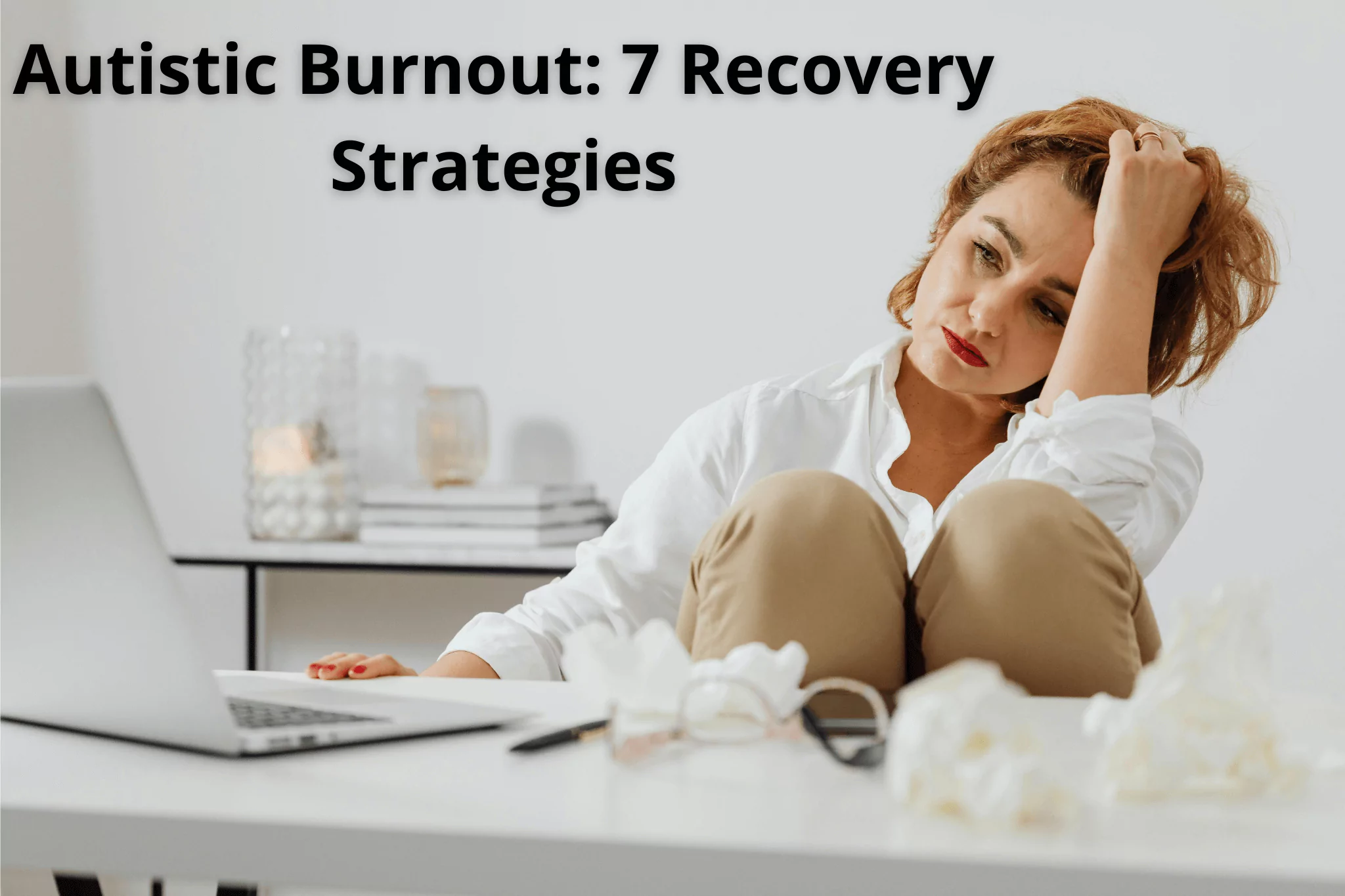With 9 years of experience in the kitchen, I’m passionate about crafting delicious recipes and sharing them with food lovers worldwide. 🍽️✨ Whether it’s a comforting homemade dish or a creative cocktail, my goal is to make cooking fun, easy, and enjoyable for everyone. Join me on this flavorful journey! 🍹🥗

Autistic Burnout: 7 Recovery Strategies
Autistic Burnout: 7 Recovery Strategies
Feeling completely drained, overwhelmed, and unable to function? You might be experiencing autistic burnout. It’s a state of exhaustion that’s more than just feeling tired; it’s a deep depletion of energy, resources, and the ability to cope with daily life. This essential guide will provide proven recovery techniques, prevention tips, and self-care strategies to help you regain energy and thrive. If you’re struggling, know that you’re not alone, and recovery is possible.
Introduction to Autistic Burnout
Autistic burnout is a significant concern within the autistic community, often misunderstood and underdiagnosed. It’s a state of intense exhaustion and reduced functionality that arises from the cumulative effect of life stressors on individuals with autism. Unlike typical burnout, autistic burnout is intricately linked to the specific challenges faced by autistic individuals, such as sensory overload, social demands, and the constant need to mask or camouflage their autistic traits. Understanding the nuances of autistic burnout is crucial for developing effective recovery and prevention strategies. Learning more about our mission can provide further insights into our commitment to supporting the autistic community.
What is Autistic Burnout?
Autistic burnout isn’t simply feeling tired after a long day. It’s a profound depletion of cognitive, emotional, and physical resources that can significantly impact an autistic person’s ability to function. It often manifests as increased sensory sensitivities, difficulty with executive functions, loss of skills (both learned and innate), increased stimming, withdrawal from social interactions, and intense feelings of overwhelm and frustration. This state is usually the result of prolonged exposure to stressors without adequate recovery time. The autistic individual may find it increasingly difficult to manage daily tasks, leading to feelings of inadequacy and despair. It is important to note that autistic burnout can present differently in each individual, and its severity can vary widely.
Core Principles of Recovery from Autistic Burnout
The core principles of recovering from autistic burnout revolve around understanding your individual needs, prioritizing self-care, and creating an environment that supports your well-being. Here are some crucial aspects to consider:
- Self-Awareness: Recognizing your triggers, sensory sensitivities, and coping mechanisms is essential.
- Prioritization of Rest: Adequate sleep, downtime, and breaks are non-negotiable.
- Sensory Regulation: Implementing strategies to manage sensory input is crucial.
- Reduced Demands: Minimizing social and environmental pressures allows for recovery.
- Self-Compassion: Be kind to yourself and acknowledge your limitations.
- Authenticity: Embrace your autistic identity and reduce the need to mask.
By embracing these principles, you can pave the way for a sustainable recovery from autistic burnout.
Key Components in Burnout Management
Effectively managing autistic burnout involves several key components that address both the symptoms and the underlying causes. These include:
- Stress Reduction: Identifying and mitigating stressors is critical for preventing further burnout.
- Sensory Diet: Implementing a personalized sensory diet to regulate sensory input and manage sensitivities.
- Executive Function Support: Utilizing tools and strategies to support executive function challenges.
- Emotional Regulation: Developing coping mechanisms to manage emotions and prevent overwhelm.
- Sleep Hygiene: Establishing a regular sleep schedule and creating a conducive sleep environment.
- Nutrition: Ensuring a balanced diet to support energy levels and overall well-being.
Addressing these components can significantly improve the symptoms of autistic burnout and promote long-term recovery.
Developing Your Autistic Burnout Recovery Framework
Developing a personalized recovery framework is crucial for overcoming autistic burnout. This framework should be tailored to your specific needs, strengths, and challenges. Start by identifying the factors that contribute to your burnout, such as sensory overload, social demands, or executive function difficulties. Then, develop strategies to address these factors. This might involve creating a sensory-friendly environment, setting boundaries with others, or implementing assistive technology. Remember, your recovery framework should be flexible and adaptable, allowing you to adjust it as your needs change. Don’t hesitate to explore our services for personalized support in developing your framework.
Goal Setting for Your Autistic Burnout Recovery
Setting realistic and achievable goals is an essential part of the autistic burnout recovery process. These goals should be specific, measurable, achievable, relevant, and time-bound (SMART). For example, instead of setting a vague goal like “feel better,” you could set a specific goal like “spend 30 minutes each day engaging in a relaxing activity, such as reading or listening to music.” Break down larger goals into smaller, more manageable steps to avoid feeling overwhelmed. Celebrate your progress along the way, and be patient with yourself. Recovery takes time, and it’s okay to have setbacks.
Self-Assessment in Autistic Burnout Recovery
Regular self-assessment is crucial for tracking your progress and adjusting your recovery strategies as needed. Keep a journal to document your energy levels, mood, and any challenges you encounter. Pay attention to your sensory sensitivities and identify any triggers that exacerbate your burnout. Use rating scales or questionnaires to track your progress over time. Be honest with yourself about your limitations and be willing to ask for help when you need it. Seeking input from trusted friends, family members, or professionals can also provide valuable insights.
Implementing Sensory Regulation Strategies
Sensory regulation is a cornerstone of autistic burnout recovery. Many autistic individuals experience sensory sensitivities that can contribute to overwhelm and exhaustion. Identifying your specific sensory sensitivities and developing strategies to manage them is crucial. This might involve wearing noise-canceling headphones, using weighted blankets, creating a calm and quiet space, or engaging in sensory activities that you find calming and regulating, such as stimming. Experiment with different strategies to find what works best for you. You can find a variety of resources on sensory regulation at Autism Speaks: Autism Speaks.
Creating a Sensory-Friendly Environment for Recovery
Your environment can have a significant impact on your sensory experience. Creating a sensory-friendly environment can help reduce sensory overload and promote relaxation. This might involve reducing clutter, minimizing noise, adjusting lighting, and using natural materials. Consider your specific sensory sensitivities and make adjustments accordingly. For example, if you are sensitive to bright lights, you might use dimmer switches or blackout curtains. If you are sensitive to certain textures, you might replace rough fabrics with soft ones. Creating a comfortable and supportive environment is essential for autistic burnout recovery.
Using Assistive Technology for Burnout Management
Assistive technology can be a valuable tool for managing autistic burnout. There are many different types of assistive technology available, including apps, software, and devices that can help with executive function, communication, sensory regulation, and emotional regulation. For example, you might use a task management app to help with organization, a noise-canceling app to reduce auditory distractions, or a weighted blanket to promote relaxation. Explore different options and find what works best for you. Consult with an occupational therapist or assistive technology specialist for guidance.
Content Strategy for Emotional Wellbeing
While seemingly unrelated, managing digital content intake can significantly impact emotional wellbeing during autistic burnout. Overconsumption of news, social media, and other online content can be overwhelming, contributing to sensory overload and anxiety. A mindful approach to content consumption is therefore essential. This involves curating your online environment to prioritize positive and supportive content, setting limits on screen time, and taking regular breaks from digital devices. Unfollowing accounts that trigger negative emotions and seeking out content that promotes relaxation and well-being can also be beneficial. Remember, taking care of your mental health is just as important as taking care of your physical health, so don’t hesitate to contact us for support.
Identifying and Reducing Stressors to Prevent Autistic Burnout
Identifying and minimizing stressors is a crucial step in preventing autistic burnout. Keep a journal to track your daily activities and identify potential stressors. Common stressors for autistic individuals include sensory overload, social demands, changes in routine, and unclear expectations. Once you have identified your stressors, develop strategies to minimize their impact. This might involve setting boundaries with others, avoiding situations that trigger sensory overload, or creating a predictable routine. Remember, it’s okay to say no to demands that exceed your capacity.
Prioritizing Rest and Downtime in Your Routine
Rest and downtime are essential for preventing and recovering from autistic burnout. Schedule regular breaks throughout the day to allow yourself time to recharge. Engage in activities that you find relaxing and enjoyable, such as reading, listening to music, or spending time in nature. Prioritize sleep and establish a regular sleep routine. Avoid overcommitting yourself and learn to say no to demands that will deplete your energy. Remember, rest is not a luxury; it’s a necessity for maintaining your well-being.
Support Networks and Community in Autistic Burnout Recovery
Connecting with others who understand your experiences can be incredibly validating and empowering. Building a strong support network and engaging with the autistic community can provide a sense of belonging, reduce feelings of isolation, and offer valuable insights and coping strategies. Consider joining online forums, support groups, or local autism organizations. Sharing your experiences and connecting with others who have been through similar challenges can be incredibly therapeutic. Remember, you are not alone.
Building a Strong Support System
A strong support system can provide invaluable emotional, practical, and social support during autistic burnout recovery. Identify trusted friends, family members, or professionals who understand your needs and are willing to offer support. Communicate your needs clearly and assertively. Don’t be afraid to ask for help when you need it. Remember, building a strong support system takes time and effort, but it is well worth the investment.
Professional Support for Autistic Burnout
In some cases, professional support may be necessary to effectively manage autistic burnout. Therapists, counselors, occupational therapists, and other professionals can provide guidance, support, and evidence-based interventions to help you recover. Consider seeking professional help if you are struggling to manage your symptoms on your own or if your burnout is significantly impacting your quality of life. A professional can help you develop coping strategies, address underlying issues, and promote long-term recovery.
Measuring Progress in Autistic Burnout Recovery
Tracking your progress is essential to staying motivated and adjusting your strategies as needed. Establish metrics to gauge your recovery journey. This allows for concrete evaluation of your wellbeing and what adjustments might be necessary. Celebrate successes, no matter how small, to reinforce positive habits and maintain momentum.
Tracking Energy Levels and Mood
Monitoring your daily energy levels and moods provides insights into your overall well-being and guides your recovery from autistic burnout. Use a journal or a mood-tracking app to log your energy levels on a scale of 1 to 10, recording any factors that may have influenced them. Similarly, track your mood throughout the day, noting any triggers or patterns. This data helps identify activities or situations that contribute to increased energy or emotional fluctuations, enabling you to tailor your routine and strategies accordingly.
Adjusting Strategies for Long-Term Management of Autistic Burnout
Long-term management of autistic burnout requires flexibility and adaptability. Regularly evaluate your current strategies and make adjustments as needed based on your progress and evolving needs. As you recover, you may find that some strategies are no longer as effective or that new challenges arise. Embrace change and be willing to experiment with different approaches to find what works best for you in the long run. This proactive and iterative approach ensures that your strategies remain relevant and supportive, fostering sustained well-being.
Advanced Strategies for Building Resilience
Building resilience is crucial for navigating the inevitable challenges that contribute to autistic burnout. These advanced strategies go beyond basic self-care and focus on developing inner strength and adaptability. This section will discuss practices such as mindfulness, self-compassion, and advocating for one’s own needs, all of which empower individuals to manage stress and maintain well-being in the face of adversity.
Mindfulness and Self-Compassion in Preventing Autistic Burnout
Integrating mindfulness and self-compassion practices into your daily routine can significantly reduce the risk of autistic burnout. Mindfulness involves paying attention to the present moment without judgment, fostering a greater awareness of your thoughts, feelings, and sensory experiences. Self-compassion entails treating yourself with kindness and understanding, especially during challenging times. Practicing mindfulness and self-compassion can help you manage stress, reduce anxiety, and cultivate a more positive and accepting attitude towards yourself. There are numerous resources available to help you learn and practice these techniques, including guided meditations and self-compassion exercises.
Advocating for Your Needs and Boundaries
One of the most effective ways to prevent autistic burnout is to advocate for your needs and boundaries. This involves clearly communicating your limitations and preferences to others, setting healthy boundaries, and asserting your right to prioritize your well-being. This might mean saying no to social engagements that you know will be overwhelming, asking for accommodations in the workplace or at school, or educating others about your sensory sensitivities. Advocating for your needs can be challenging, but it is essential for protecting your energy and preventing burnout.




